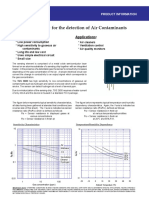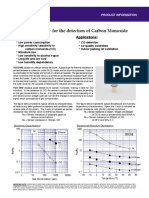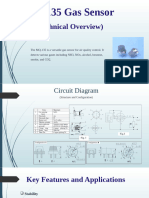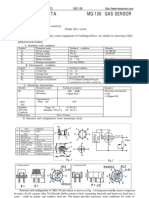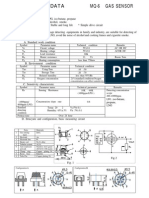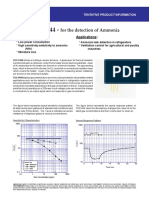TGS 244
TGS 244
Uploaded by
Tugino GinoCopyright:
Available Formats
TGS 244
TGS 244
Uploaded by
Tugino GinoOriginal Description:
Original Title
Copyright
Available Formats
Share this document
Did you find this document useful?
Is this content inappropriate?
Copyright:
Available Formats
TGS 244
TGS 244
Uploaded by
Tugino GinoCopyright:
Available Formats
TENTATIVE PRODUCT INFORMATION
TGS 2444 - for the detection of Ammonia
Features:
Applications:
* Low power consumption
* High sensitivity/selectivity to ammonia
(NH3)
* Miniature size
* Ammonia leak detection in refrigerators
* Ventilation control for agricultural and poultry
industries
TGS 2444 utilizes a multilayer sensor structure. A glass layer for thermal insulation
is printed between a ruthenium oxide (RuO2) heater and an alumina substrate. A pair
of Au electrodes for the heater are formed on a thermal insulator. The gas sensing
layer, which is formed of tin dioxide (SnO2), is printed on an electrical insulation layer
which covers the heater. A pair of Au electrodes for measuring sensor resistance
are formed on the electrical insulator.
TGS 2444 displays good selectivity to ammonia, making it ideal for critical safety-related
applications such as the detection of ammonia leaks in refrigeration systems and
ammonia detection in the agricultural field. In the presence of ammonia, the sensor's
conductivity increases depending on the gas concentration in the air. A simple pulsed
electrical circuit operating on a 250msec circuit voltage cycle can convert the change
in conductivity to an output signal which corresponds to gas concentration.
The figure below represents typical sensitivity characteristics,
all data having been gathered at standard test conditions (see
reverse side of this sheet). The Y-axis is indicated as sensor
resistance of displayed gases at various concentrations:
The figure below represents the typical response pattern of
TGS2444 when the atmosphere changes from clean air to the
listed gas concentrations and then reverts back to clean air:
Sensitivity Characteristics:
Sensor Response Pattern:
1000
1000
air 10ppm NH3
air
100
100
Rs(k)
10
Rs(k)
10
Air
Ammonia
Ethanol
H2S
0.1
0.1
10
15
20
25
30
Time/ min.
10
100
1000
Gas Concentration (ppm)
IMPORTANT NOTE: OPERATING CONDITIONS IN WHICH FIGARO SENSORS ARE USED WILL VARY WITH EACH CUSTOMERS SPECIFIC APPLICATIONS. FIGARO STRONGLY
RECOMMENDS CONSULTING OUR TECHNICAL STAFF BEFORE DEPLOYING FIGARO SENSORS IN YOUR APPLICATION AND, IN PARTICULAR, WHEN CUSTOMERS TARGET
GASES ARE NOT LISTED HEREIN. FIGARO CANNOT ASSUME ANY RESPONSIBILITY FOR ANY USE OF ITS SENSORS IN A PRODUCT OR APPLICATION FOR WHICH SENSOR HAS
NOT BEEN SPECIFICALLY TESTED BY FIGARO.
Basic Measuring Circuit:
Circuit voltage (V C) is applied across the
sensing element which has a resistance (Rs)
between the sensors two electrodes (pins No.
2 and No. 3) and a load resistor (RL) connected
in series. The sensing element is heated by
the heater which is connected to pins No. 1
and No. 4.
Heating cycle--The sensor requires application
of a 250 msec heating cycle which is used
in connection with a circuit voltage cycle of
250 msec. Each VH cycle is comprised by
4.8V being applied to the heater for the first
14ms, followed by 0V pulse for the remaining
236ms. The Vc cycle consists of 0V applied
for 2msec, followed by 5.0V for 5ms and 0V
for 243msec. For achieving optimal sensing
characteristics, the sensor's signal should
be measured after the midpoint of the 5ms
Vc pulse of 5.0V (for reference, see timing
chart below).
NOTE: Application of a Vc pulse condition
is required to prevent possible migration of
heater materials into the sensing element
material. Under extreme conditions of high
humidity and temperature, a constant Vc
condition could result in such migration and
cause long term drift of Rs to higher values.
A 5ms Vc pulse results in significantly less
driving force for migration than a constant
Vc condition, rendering the possibility of
migration negligibly small.
Structure and Dimensions:
250msec
VH
VHH
VHL 0 V
VC
5. 0 V
unit:mm
14 m s
4.8V
7msec
5msec
Detection point
0V
9.20.2
Specifications:
8.10.2
Model number
TGS2444
Sensing element type
M1
Standard package
TO-5 metal can
Target gases
Ammonia
Typical detection range
Standard circuit conditions
Electrical characteristics under standard test conditions
10 ~ 100ppm
Heater voltage cycle
VH
Circuit voltage cycle
VC
VC=0V for 245ms
VC=5.0V0.2VDC for 5m
RL
RH
172.5 at room temp.
Heater current
IH
approx. 203mA (in case of VHH)
Heater power
consumption
PH
56mW (typical)
Sensor resistance
RS
Circuit conditions
Conditioning period before
test
variable
RL8k
3.60.1
2.2k ~ 44.6k in 10ppm of ammonia
Rs(NH3 100ppm)
Rs(NH3 10ppm)
0.06 ~ 0.63
Ammonia in air
at 202C, 655%RH
Same as Std Circuit Condition
(above)
48 hours
Operating conditions
-10C~+50C w/o dew condensation
Less than absolute humidity corresponds to 40C/80%RH
Storage conditions
-20C~+60C w/o dew condensation
Less than absolute humidity corresponds to 60C/90%RH
Sensor resistance (Rs) is calculated with a measured value
of Vout as follows:
Vc x RL
Rs =
- RL
Vout
For information on warranty, please refer to Standard Terms and Conditions of Sale of Figaro
USA Inc.
REV: 11/10
10.01.0
(see timing chart for measurement timing)
Heater resistance
Test gas conditions
Standard test conditions
VHH=4.8V0.2VDC for 14ms
VHL=0V for 236ms
Load resistance
Sensitivity
(change ratio of Rs)
7.80.5
90C
3.60.1
5.1
Pin connections:
1: Heater
2: Sensor (-)
3: Sensor (+)
4: Heater
FIGARO ENGINEERING INC.
1-5-11 Senba-nishi
Mino, Osaka 562
JAPAN
Phone: (81)-72-728-2561
Fax: (81)-72-728-0467
www.figaro.co.jp
email: figaro@figaro.co.jp
You might also like
- Combust Gas Detector Manual 4101-02B1Document15 pagesCombust Gas Detector Manual 4101-02B1eliasx1No ratings yet
- Industrial Applications of Infrared Thermography: How Infrared Analysis Can be Used to Improve Equipment InspectionFrom EverandIndustrial Applications of Infrared Thermography: How Infrared Analysis Can be Used to Improve Equipment InspectionRating: 4.5 out of 5 stars4.5/5 (3)
- For The Detection of Carbon Monoxide: Applications: FeaturesDocument2 pagesFor The Detection of Carbon Monoxide: Applications: FeaturesFito PaezNo ratings yet
- 821 PDFDocument2 pages821 PDFemrenormNo ratings yet
- TGS 842Document2 pagesTGS 842Cesar TemocheNo ratings yet
- TGS2106Document2 pagesTGS2106RyanSardanaNo ratings yet
- 3870 PDFDocument2 pages3870 PDFTedi RukmawanNo ratings yet
- Figaro: For The Detection of Air ContaminantsDocument2 pagesFigaro: For The Detection of Air ContaminantsarfiarfiNo ratings yet
- Tgs2600 Product Information Rev02 EkoDocument2 pagesTgs2600 Product Information Rev02 EkoNurry EkoNo ratings yet
- Lampiran 1Document2 pagesLampiran 1hme_unismaNo ratings yet
- Technical Data Mq-135 Gas Sensor: H L H HDocument2 pagesTechnical Data Mq-135 Gas Sensor: H L H HSiddharthRawatNo ratings yet
- Technical Data Mq-2 Gas Sensor: H L H HDocument3 pagesTechnical Data Mq-2 Gas Sensor: H L H HsksachinNo ratings yet
- Datasheet Sensor MQ9Document3 pagesDatasheet Sensor MQ9Harold CaraballoNo ratings yet
- MQ137 (Ver1.4) - ManualDocument6 pagesMQ137 (Ver1.4) - ManualAleX KasperNo ratings yet
- Instrument Engineer ManualDocument31 pagesInstrument Engineer ManualRonald ImmanuelNo ratings yet
- 4160 PDFDocument2 pages4160 PDFratonitoNo ratings yet
- Technical Information For Combustible Gas SensorsDocument9 pagesTechnical Information For Combustible Gas SensorsAnonymous dY2G2az1No ratings yet
- MQ303ADocument2 pagesMQ303APVPPPNo ratings yet
- TGS8100 Product InfomationDocument10 pagesTGS8100 Product Infomationbemxgm-1No ratings yet
- TGS2442 PDFDocument2 pagesTGS2442 PDFArgemiro Peñate SanchezNo ratings yet
- Project PresentationDocument9 pagesProject Presentationvikimccs786No ratings yet
- MQ 135 PDFDocument2 pagesMQ 135 PDFAries PrasetyoNo ratings yet
- MQ131 OzoneDocument2 pagesMQ131 OzoneBee Usuquen RascoNo ratings yet
- EthanolDocument2 pagesEthanolHamdan PrakosoNo ratings yet
- Technical Data Mq-2 Gas Sensor: H L H HDocument2 pagesTechnical Data Mq-2 Gas Sensor: H L H HMhmmd Agus HidayatNo ratings yet
- LPG Gas SensorDocument2 pagesLPG Gas SensorownlinkscribdNo ratings yet
- MQ 136Document2 pagesMQ 136Ghul KingNo ratings yet
- Technical Data Mq-7 Gas Sensor: FeaturesDocument3 pagesTechnical Data Mq-7 Gas Sensor: FeaturesCatur Mei RadhickaNo ratings yet
- MQ-3 Datasheet SensorDocument2 pagesMQ-3 Datasheet SensorAfif AR100% (1)
- PTC ReissmannDocument8 pagesPTC ReissmannAndré Carlos CorenzanNo ratings yet
- MQ137 Ammonia SensorDocument3 pagesMQ137 Ammonia Sensorkpkarthi80No ratings yet
- MQ 3 DatasheetDocument8 pagesMQ 3 DatasheetelvinguitarNo ratings yet
- 18.smoke SensorDocument6 pages18.smoke SensorBRAGPW,Karimnagar 087No ratings yet
- MQ 2 PDFDocument2 pagesMQ 2 PDFSanjana SinghNo ratings yet
- Technical Data Mq-5 Gas Sensor: H L H HDocument2 pagesTechnical Data Mq-5 Gas Sensor: H L H HLucho Yupanqui SantosNo ratings yet
- Alcohol Sensor: ConfigurationDocument6 pagesAlcohol Sensor: ConfigurationNiranjan ReddyNo ratings yet
- IRM-3 DUO Manual EnglishDocument33 pagesIRM-3 DUO Manual EnglishThiago Takumi TanNo ratings yet
- MQ135 (Ver1.4) - ManualDocument7 pagesMQ135 (Ver1.4) - ManualPavankumar VijapurNo ratings yet
- Sensores Toxicos ElectroquimicosDocument4 pagesSensores Toxicos Electroquimicostrukcor_1No ratings yet
- Technical Information For Carbon Monoxide SensorsDocument15 pagesTechnical Information For Carbon Monoxide Sensorssanchez_buenoNo ratings yet
- Thermistor With ICL7107 PDFDocument3 pagesThermistor With ICL7107 PDFKhalid KhassawnehNo ratings yet
- Approval Sheet: D S C Electronics Co., LTDDocument9 pagesApproval Sheet: D S C Electronics Co., LTDJorge Vásquez CarreñoNo ratings yet
- HS1101LF - Relative Humidity Sensor: DescriptionDocument6 pagesHS1101LF - Relative Humidity Sensor: DescriptionManuel_DreamNo ratings yet
- Syh 2RDocument9 pagesSyh 2RBogdan GrigoreNo ratings yet
- Technical Data Mq-6 Gas Sensor: H L H HDocument2 pagesTechnical Data Mq-6 Gas Sensor: H L H Hmd4760No ratings yet
- Bulletin11M12A01 01EDocument13 pagesBulletin11M12A01 01ECristian Branada MacayaNo ratings yet
- Sem210 Series: Programmable In-Head Universal Temperature TransmitterDocument5 pagesSem210 Series: Programmable In-Head Universal Temperature TransmitterjhuskanovicNo ratings yet
- Da 01 en Gassensor - TGS - 813Document20 pagesDa 01 en Gassensor - TGS - 813KarthikeyanKarunNo ratings yet
- NtcintroDocument10 pagesNtcintroAbhinav AgarwalNo ratings yet
- HBGS Gas Instructions Manual 006 UKDocument8 pagesHBGS Gas Instructions Manual 006 UK73992677No ratings yet
- Model 5190-C Temperature/Humidity Probe User's ManualDocument8 pagesModel 5190-C Temperature/Humidity Probe User's ManualNguyễn Văn TrungNo ratings yet
- Contactor Rollarc SF6Document24 pagesContactor Rollarc SF6Dong BachNo ratings yet
- 2620 Datasheet SensorDocument12 pages2620 Datasheet SensorFachrizal MuhammadNo ratings yet
- Ultrasound Analysis for Condition Monitoring: Applications of Ultrasound Detection for Various Industrial EquipmentFrom EverandUltrasound Analysis for Condition Monitoring: Applications of Ultrasound Detection for Various Industrial EquipmentRating: 4.5 out of 5 stars4.5/5 (3)
- Reference Guide To Useful Electronic Circuits And Circuit Design Techniques - Part 2From EverandReference Guide To Useful Electronic Circuits And Circuit Design Techniques - Part 2No ratings yet
- Reference Guide To Useful Electronic Circuits And Circuit Design Techniques - Part 1From EverandReference Guide To Useful Electronic Circuits And Circuit Design Techniques - Part 1Rating: 2.5 out of 5 stars2.5/5 (3)
- Influence of System Parameters Using Fuse Protection of Regenerative DC DrivesFrom EverandInfluence of System Parameters Using Fuse Protection of Regenerative DC DrivesNo ratings yet
- Analog Dialogue, Volume 48, Number 1: Analog Dialogue, #13From EverandAnalog Dialogue, Volume 48, Number 1: Analog Dialogue, #13Rating: 4 out of 5 stars4/5 (1)
- SilabusDocument3 pagesSilabusTugino GinoNo ratings yet
- Nama Mhasiswa: 1 Tugino Elektro 2 Slamet Mesin 3 Joko JogjaDocument1 pageNama Mhasiswa: 1 Tugino Elektro 2 Slamet Mesin 3 Joko JogjaTugino GinoNo ratings yet
- Accelerometers: EE 587 By: David JacksonDocument8 pagesAccelerometers: EE 587 By: David JacksonTugino GinoNo ratings yet
- Diesel Engine Generator: October 4-6, 2017Document4 pagesDiesel Engine Generator: October 4-6, 2017Tugino GinoNo ratings yet
- TGS 244Document2 pagesTGS 244Tugino GinoNo ratings yet
- BIL Trafo PDFDocument6 pagesBIL Trafo PDFTugino GinoNo ratings yet








